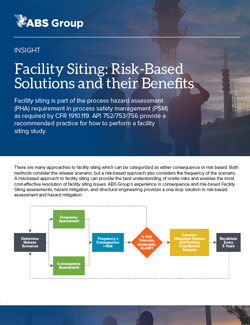Facility Siting and Revalidation Toolkit

Guidance for Facility Siting and Revalidation
Facility siting and revalidation are critical components in managing process safety and risk in oil, gas and chemical facilities. This process hazard analysis (PHA) element is also a requirement
With more than 45 years of process safety experience, ABS Group has compiled the following information resources to help you understand the latest facility siting and revalidation guidelines.
Online Resources:
Exclusive Access to ABS Group Webinars
- Occupied Building Risk Assessment and Complementary Detailed Analysis Studies
- Facility Siting: Mitigation Planning and Implementation to Address Hazards
- Cal/OSHA's PSM Regulation: Facility Siting and Revalidation
- Accidental Release Prevention Program: Seismic Assessment and Revalidating Guidelines
- Revised Chemical National Emphasis Program (CPL 03-00-021)
- Remote PSM: Facility Siting at a Distance

What You Need to Know About Facility Siting and Revalidation
Facility siting is a continuous cycle. It is intended to be revised and updated as processes and facilities change, though it is not uncommon for the initial facility siting study to be considered "the end" or the "goal."

Facility Siting: Risk-Based Solutions and Their Benefits
Facility siting is part of the process hazard assessment (PHA) requirement in process safety management (PSM) as required by CFR 1910.119. API 752/753/756 provide a recommended practice for how to perform a facility siting study.

Updated Facility Siting Standards API 752, 753, 756: What Do They Mean for Your Organization?
Facility siting is an assessment of occupied buildings to examine the potential exposure to explosion, fire and toxic hazards, updates to these regulations were announced in January 2024

Debunking the Top 3 Myths About Blast Hazards
Blast hazards are present industry-wide, commonly linked to sources such as vapor clouds, bursting vessels, and in extreme instances, acts of terrorism. While there are general rules of thumb that guide our knowledge about blast hazard effects and assessments, there are also common misconceptions.

How to Mitigate Risk with Fire and Gas Detection Mapping
Fire and Gas Detection Systems (FGS) are critical components for the overall safety and operation of any facility and its personnel. Using dedicated field devices, FGS detection continuously monitors heat, smoke, temperature and toxic or combustible gas levels.
Additional Resources and Training
View more learning tools related to PHA, PSM and facility siting, including relevant training courses in 2018 such as Facility Siting Hazard Analysis Techniques and Revalidating Process Hazard Analyses.